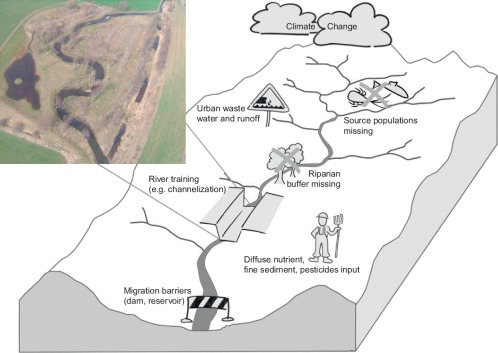In the News
2024 END OF YEAR CELEBRATION
Theme: River Ecology, Restoration, and Water Quality
Tuesday, December 10, 2024
1:00 PM - 2:30 PM ::
1022 HN
RSVP HERE

Hello Everyone,
As the semester draws to a close, we are excited to announce our annual celebration of the end of the year as part of Geography Awareness Week. This event will be organized and hosted jointly by the Department of Geography and Environmental Science at Hunter College (CUNY) and the Greenbelt Society, and will be held on Tuesday, December 10, 2024 between 1:00 PM and 2:30 PM (Eastern Time, US-Canada) in room 1022 HN. During the first part of the celebration, we will have three speakers that present their projects focused on ecological restoration of rivers and canals as well as workshops focused on teaching students about techniques of data collection and analysis. After the presentations we will have a party offering pizza and beverages. Please join us in this celebration event! RSVP required at https://forms.gle/Pt5Y5nXQfMqEs8sm6
Presentations:
Shoestring Fieldwork
Presenter: Frankie Placencia
Affiliation: Department of Geography and Environmental Science, Hunter College
Description of Project: This presentation is a proposal for a series of fieldwork workshops organized by the Greenbelt Society to address the lack of hands-on training opportunities in field data collection within our geography department. These workshops would aim to teach foundational skills for the life sciences, such as data collection, tool usage, and analysis, with an emphasis on intentionality and practical application. Our ultimate goal is to equip students with the tools to gather reliable data and avoid the pitfalls of poor data leading to poor results.
The Elwha River Dam Removal and the Current Ecological Crisis
Presenter: Dr. Enrique Lanz Oca
Affiliation: Department of Geography and Environmental Science, Hunter College
Description of Project: From traditional watermills to the iconic Hoover dam, dams have facilitated a welcomed transformation of the American landscape. However, when the Glen Canyon Dam was built in the 1960s, public opinion about dams was beginning to change. And nowadays, dams are removed with a public fanfare similar to the spirit in which they were once built. Nearly 1,300 dams have been dismantled since 1916. The Elwha Project in Washington State is the largest dam removal in history, and its removal may spur other demolitions such as the Klamath dams in Oregon and California. The common reasons for decommissioning dams are river restoration, aging and obsolescence, safety, high cost of repair and maintenance, recreational opportunities, and water quality. But now a new and more pressing reason is emerging. Recent and unprecedented events such as unusual winter precipitation in California have jarred us into perceiving dam infrastructure in a new way, as the public has been subjected to images of dams on the brink of collapse, from Oroville in California, to the collapse of the Derna Wadi dams in Libya. Based on interviews, primary and secondary sources, and direct observation, this paper argues that climate change, never before even considered as a reason to examine and remove dams, should become one of the most important criteria.
— — —
Water Pollution at the Gowanus Canal
Presenter: Alex Wiercioch
Affiliation: Department of Geography and Environmental Science, Hunter College
Description of Project: This presentation will discuss water pollution at the Gowanus Canal by looking at the waterway’s history, the root cause of pollution, the current rezoning, and potential mitigation methods. I will first cover the canal’s history, discussing Gowanus Bay and its original use by the Lenape Tribe and the Dutch, its transformation into the polluted Gowanus Canal, and issues with cleaning the waterway. I will then discuss combined sewage overflows (CSOs), which are responsible for constantly polluting the canal. Afterward, I want to talk about the current Gowanus Neighborhood Rezoning, a controversial project that plans to expand housing and development in an area that is next to a toxic pile of water. Lastly, I will discuss mitigation methods like green infrastructure and their ability to reduce CSOs, as well as clean the contaminated area.
— — —
Climate Change Impact on Combined Sewer Overflows (CSOs) in New York City
Presenter: Dr. Jingyu Wang
Affiliation: Department of Geography and Environmental Science, Hunter College
Description of Project: Climate change significantly increases frequency and intensity of heavy rainstorms. It causes larger volume of sewage overflows into New York City (NYC) waterways, leading to increased concentrations of nutrients, bacteria, turbidity, and other contaminants, causing water pollution, degrading water quality, impacting aquatic life and fish consumption safety.
There are 60% sewage system is combined sewer in NYC, a singe pipe carry both stormwater runoff and sewage from buildings. Usually the mixture is sent to wastewater treatment plant (WWTP). During heavy rainstorms, the mixture volume exceeds WWTP’s capacity. When this happens, combined sewer overflows (CSOs) discharge untreated sewage mixed with stormwater directly into NYC’s waterways. These events elevate nutrients and bacteria concentrations, degrade water quality, and threaten fish consumption safety.
Water sampling of CSOs were conducted during heavy rainstorms. Then analyzed pH, EC, ammonia, phosphate, turbidity, fecal coliform, E.Coli., and enterococcus in Environmental, Chemistry and Biology laboratories in CUNY. Results showed contaminants concentrations were significantly higher than NYC DEP regulated levels. During tropical storm Arthur on July 2nd, 2014, rain volume was 6.97 inch. Ammonia concentration was 2.725 mg/L that was significantly higher than standard of 0.23 mg/L. Enterococcus was 10,000 that was significantly higher than standard of 124 MPN/ml. During the rainstorm on October 28, 2015 with volume of 1.44 inch, enterococcus was 65,000 MPN/100ml. The tropical downpour dumped 1.95 inches of rain with high intensity in the afternoon of July 30, 2015, and ammonia was 2.598 mg/L. Turbidity was 319 FAU.
Overall, results showed higher rain volume and intensity caused larger volume of CSOs and higher concentrations of ammonia, phosphate, turbidity and bacteria.

